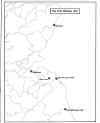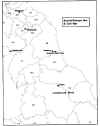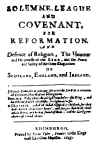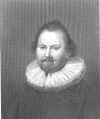|
The Bishops Wars and
Wars of the Three Kingdoms (1639-1646)
The best known events of
the Covenanters tend to be the pivotal National Covenant (1638), the
Solemn League and Covenant (1643) and the horrors of “The Killing Time”
(1684-5). But in between there were other events of significance which
should not be overlooked. Not least of these were “The Bishops Wars” and
the ongoing interference of the three countries – England, Ireland and
Scotland – in one another’s affairs.
Over the course of 1639 and
1640 Charles I was to clash twice with his Scottish subjects in the
Bishops Wars, so-called because of the resistance by the Presbyterians to
the rule by bishops (episcopacy). But there were also in a short space of
time the rebellion of the Catholic Irish (and Old English settlers from
Norman times) in October, 1641, for which a Scots army went to Ireland in
1642. Meanwhile, Civil War erupted in England in August 1642 in which the
Covenanters’ Army became embroiled after the signing of the Solemn League
and Covenant in 1643. And as if that wasn’t enough, an Irish force under
Alasdair McColl (or MacDonald) landed in Argyll in 1644 and joined up with the royalist
forces under the Marquis of Montrose. Thus Scotland was involved in wars
on three fronts for three different reasons: the Covenanters for religion;
the political objectives for a Greater Britain; and, the private ambitions
of Argyll over the Lordship of the Isles.
Following the National
Covenant of 1638 there was a wave of euphoria that surged through the
Presbyterian leaders resulting in dreams of extending “the royal
prerogative of King Jesus … through all the earth”. For the King there
were significant dangers as not only were the Covenanters challenging his
authority in Scotland, it also stimulated the Puritan movement in England
who for very long time had been pressing for simplification in the
Church of England. What did emerge from the short rule of the Covenanters
was a more representative Parliament and thereby the establishment of a
Scottish House of Commons.
The Bishops Wars were
almost non-events with little real fighting at national level, but was an
excuse for feuding between local families in the north east and west of
Scotland. Following the signing of the
National Covenant the Marquis of Hamilton, the King`s Commissioner, is
thought by some to have thrown in the towel. But he was in fact trying
very hard to get the King to acknowledge the Covenant and take the sting
out of the potential rebellion. In June 1638 he fobbed off representations
for an Assembly and Parliament; twice he returned to the Court in London
to consult with the King and tried to get him to change his
confrontational approach. At this time there was still goodwill among the
Presbyterians generally and had Charles accepted an explanation of the
Covenant as not being rebellion, there was potential to win over a
substantial proportion of the middle of the road Presbyterians. Hamilton
meanwhile had also drawn up lists of 25 Covenanters divided into
five categories – nobles, barons, burgesses, ministers and advocates. The
nobles included the Earls of Rothes, Lothian, Weymes; Lords Eglinton,
Lindsay, and Balmerino. A second list was of 46 nobles who might be
supporters of the Crown and included those who were waverers or at least
pragmatists who would listen to reason. These included the Duke of
Lennox, Marquis of Huntly, Earl of Traquair, and the Catholic Marquis of
Douglas and the Earl of Abercorn. Among the pragmatic waverers were the Earls
of Southesk, Lauderdale, Dunfermline, Glencairn, Haddington and
Tullibardine. Thus armed Hamilton had at least a chance of brokering an
agreement or dividing the Presbyterian opposition. But Charles was his arrogant and adamant
self, and a chance for compromise was lost. Charles then encountered problems
recruiting militia in the North of England, while a force of 5000 troops
was placed on board a naval expeditionary force that arrived in the Forth
in May 1639. The problem with this was that the men were untrained and
less than 200 of them had ever held a musket. To make matters worse most
of the guns were broken. With the royalist forces in disarray it was
fortunate that avenues of communication remained open and both sides came
round to seeking a solution before a battle actually broke out.
The Bishops Wars
The first Bishop’s War
began in March 1639 and lasted for about five weeks
during which there was skirmishing in Invernessshire. Covenanters under
the command of the Marquis of Montrose and General Leslie took the city of
Aberdeen marching under flags bearing the legend “For Religion, the
Covenant and the Country”. The rank and
file wore a blue scarf across their chests and under the left arm called
“the Covenanter’s ribbon”. In this campaign the Earl of Huntly was seized
and taken to Edinburgh, although the first serious blood to flow occurred
on May 10, in the “Trot of Turriff”, which was a victory for the royalists
followed by their recapturing Aberdeen. However, Montrose and Leslie
chased them out again within the month.
In the south, the
Covenanters took control of the strong castles of Dumbarton and Edinburgh
and by May they had some 20,000 men in arms. On May 9, Leslie was
commissioned to command it “for defence of the Covenant, for religion,
crown and country”. King Charles meanwhile was approaching with an army of
about 21,000 and had issued a proclamation at Newcastle offering
representation in Parliament and requiring the Scots to withdraw ten miles
from the border. Leslie and his troops camped at Duns Law 12 miles away.
The main battle proposed by
Charles never developed: instead there was a low-key standoff at Duns Law
in the Borders on June 5, 1639, followed by the Treaty of Birks (Berwick) thirteen days later. This came about through Wentworth in Ireland despatching John Lesley, Bishop of Raphoe, to counsel Charles. The king was in dire straits with his commander in chief , the Earl of Arundel; and Lord Holland as General of the cavalry. Both were totally incompetent favourites at court, without any military experience, which they proved in the field and justified Wentworth`s contempt for them. Lesley, a Scot, knew the lie of the land and his countrymen and concurred with the advice sent to postpone the attack on Scotland for at least a year and keep the Scots in play with treaties. At last Charles saw light and privately sent a message back with Lesley, for Wentworth to come to Whitehall as soon as he could. The Covenanters withdrew with Charles’ undertaking to accept civil and ecclesiastical control by the Parliaments and Assemblies respectively, ringing in their ears.
 The The
treaty was at best a convenient breathing space but was rejected by the
Assembly and The Estates. In August, 1640, the Second Bishops War saw the
Covenanting army make a pre-emptive strike and pushed the Royalist forces
back to the River Tyne, defeated it at the battle of Newburn on August 28
and entered the city of Newcastle on the 30th. Although some pockets of
resistance remained for a while – Caerlaverock Castle and Edinburgh held
out till September, the Treaty of Ripon on October 26, 1640, concluded
hostilities. The detail was referred back to the English Parliament which had offered £200,000 towards a settlement ( not as the King and Wentworth had hoped – to fund further war).
It is of note that that
the leading dissenting nobles – Loudon, Eglinton and Rothes – led
regiments in the First Bishops War and many feudal nobles regained their
status of old as warlords. Their troops also included a backbone of
professional officers and sergeants – the army commander was Alexander
Leslie, a former field marshal in the Swedish Army.
Many of the regiments also had their own
ministers with them such that over a third of the ministers of the Kirk
served in the dozen or so armies of the Covenant conveying the message of
it being a holy war. But there was also an element of settling old scores,
with Archibald Campbell, the eighth Earl and first Marquis of Argyll,
engaged in a private war in the Braes of Mar, Atholl, Angus and Rannoch
before he moved on to secure Dumbarton Castle against a threat from
Ireland.
The Bishops Wars did not,
however, bring a feeling of security to any of the combatants. In Scotland
there was a move for political change and significantly no representation
was given the Covenanters on the newly formed executive, “The Committee of
Estates”. The English Parliamentarians meanwhile, were fearful of the
price the Scots might ask for their support whether in terms of money or
religion.
The Marquis of Argyll, meanwhile, had
his own agenda and saw the prospect of further war between himself and the MacDonalds, both Scots and Irish, which had centred on Kintyre and the
islands of Colonsay and Islay in 1639. Moreover, any such attack on him
by the Earl of Antrim would be with the support of the Crown. It was a situation that could well have been a stand off,
The reaction of the
Covenanters to the English Civil War was to try and keep out of it,
however, in August 1643 the English parliament appealed to the new and
political Committee of Estates. Within days a draft of the Solemn League
and Covenant was produced. In
return for a promise to give military help to the English
Parliamentarians opposing the King, the Covenanters
entered into a “Solemn League and Covenant. .
This sought complete uniformity of religion in Britain –
the adoption of Presbyterianism as the approved church in
England and Ireland. The Covenant was adopted by the Kirk
in Scotland but it was never formally endorsed by the
English Parliament. At last it seemed to the Covenanters
that their goal was in sight but joy was relatively short
lived. Three months later a
Scottish Army of the Covenant under Alexander Leslie (now Earl of Leven)
crossed the Border and were met with resistance at Newcastle which they
bypassed. Attacking York, they were able to play a significant part in
Charles’ defeat at Marston Moor in July 1644. Returning to Newcastle, the
Covenanters besieged the city which finally surrendered in October.
After the
King’s execution in 1649 the Scots immediately proclaimed
his son Charles II King of Scotland (and also of England
and Ireland) conditional upon him accepting
Presbyterianism and the Covenants. Under considerable
pressure the King signed in June 1649. This was
unacceptable to Cromwell who now ruled England, and there
followed a bloody battle at Dunbar where he showed no
mercy. Many were killed and hundreds exiled to the
Plantations in Ireland, America and the West Indies. From
then until 1660 the Covenanters were again repressed under
the civil law, although they enjoyed the same toleration
that Cromwell allowed for all Non Conformist creeds,
including Catholics.
Montrose Changes Sides
There was dissension in
the ranks as James Graham, fifth Earl and first
Marquis of Montrose had formed the “Cumbernauld Bond” which was a pledge
with other nobles who were concerned by the politics of Argyll, to promote
the public aims of the Covenant against the private advantage.
Montrose also had second thoughts about the
National League and Covenant, objecting to the pledge under cover of
religion, to wrest the regal authority from the king. Whether this was so,
or pique at not being made the commander of the armies, or more likely
that his arch enemy Argyll had pride of place among the Covenanters.
Whatever the reason he took up arms for the king.
So 1644 also saw the direct
intervention of the Irish soldiers in Scotland. Led by Alastair MacDonald,
son to Coll the left handed of Colonsay (ousted by the Campbells from
Colonsay), and a MacDonald of Dunnyveg, he was close kin to the Earl of
Antrim. With him came some 1000 clansmen with families and cattle who
landed at Ardnamurchan on the west coast of Scotland and joined up with
Montrose at Blair Atholl. There
followed a golden year for Montrose and his army with victory at Tippermuir near Perth on September 1, 1644, where 1300 Covenanters lay
dead and 800 captured. At the Bridge of Dee his troops saw off the best
the Covenanters could offer and sacked Aberdeen with three days of
pillage, rape and murder. They then
dashed headlong through the passes of the southern Highlands to attack and
loot Castle Campbell at Dollar, in the heartland of Argyll and Clan
Campbell. Argyll himself managed to escape only to be thrashed again at
Inverlochy, on February 2, 1645, where 1500 Campbell clansmen lay dead on
the field of battle. Further successes
followed at Auldearn near Nairn (May 9) with 2000 Covenanter troops
killed, Alford (July 2) and at Kilsyth (15 August) on the Borders where he
swept the Covenanter army down the hill to have Scotland at his feet.
With the government and Argyll
fled into England, Montrose made peace with the local noblemen and burghs.
But fate and the self- interest of his supporters deserted him with his
Gordon soldiers leaving in a huff, and the Irish left to go and settle
some more old scores with the Campbells.
Thus weakened, his luck ran out at
Philiphaugh in September, 1645, where lacking good intelligence he was
routed by David Leslie and the Covenanter Army. Montrose fled to exile on
the Continent to return over four years later in support of Charles II,
but he ended his life on the gallows in Edinburgh.
Meanwhile the
alliance was under strain with the Scots complaining that the promised
monies for the army was much delayed, its needs were not being met

and the hope of religous uniformity was fading. The English
Parliamentarians saw Scottish forces being withdrawn to meet Montrose and
feared another deal with King Charles.
Elsewhere, Alexander Leslie, Lord Leven, turned to towards Newark, the
last surviving stronghold in the Midlands that Charles held. The seige
began in November 1645 and was still in progress on May 5, 1646, when
Charles made his way to surrender to the Scottish Army.
The Civil War
was at an end leaving the hard line Covenanters once again in charge of
Scotland. King Charles meanwhile was taken to Newcastle where he was held
prisoner, much to his disgust.
On 24 July the Propositions, the
final ultimatum of the Solemn League and Covenant, were put to the king.
These required him to accept the Covenant, establish religious uniformity
in Scotland and England, yield his partisan supporters and surrender
control of the militia for twenty years.
The Scots
wanted to get out of the alliance and to withdraw its army but the English
Parliamentarians resolved that they could do as they wished with the king
while he remained on English territory. This placed the Scots in a dilemma
as they either had to give up “their” king or face the might of the
Independent’s army – the New Army of Cromwell.
Practical considerations finally
held the day with the Scots accepting £400,000 in full discharge of their
claim for arrears of pay etc. On February 3, 1647, half payment was made
and on the same day Charles was handed over to the Parliament’s
Commissioners.
Here ended the
aspirations of the Solemn League and Covenant. But there was yet more intrigue to come – a
split in the Covenanter ranks and another treaty with King Charles (the Engagement) which
would end with the Kings execution and the Union of three countries into the Republic of Britain, under
the Protectorate of Oliver Cromwell.
Next:
Montrose`s campaign.
|